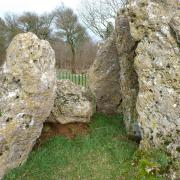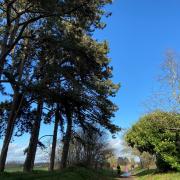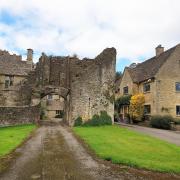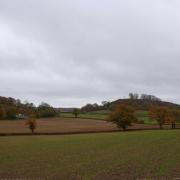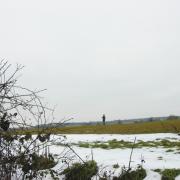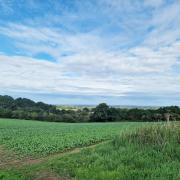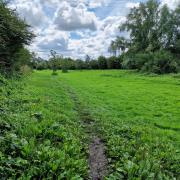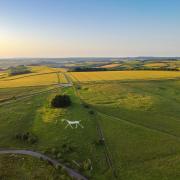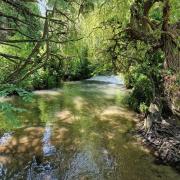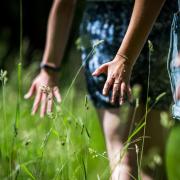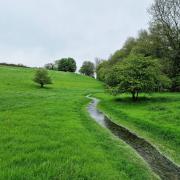A tale of a Welsh knight and his wife’s devoted love weaves in and out of Cirencester’s city walls in the last years of Romano-British civilisation
Cirencester is styled today the ‘Capital of the Cotswolds’. It Roman times, it was much more: Corinium was the second-biggest city in Britain, capital of the province of Britannia Prima. A story from the time of King Arthur provides impetus for this month’s tour of the city’s Roman infrastructure, still largely intact in his day, when the Roman legions had gone but the Saxons had not yet overrun the country.
If you park in The Whiteway, we can begin the walk amidst the prehistoric barrows north of town where the Romans avoided building. Walk across the rugby club car park to the gallery of trees on the far side and take the path northeast through them. From a gap in the fence on your right, proceed along the top edge of the field, through a gap in another fence and around the outside of a cricket field. Some barrow-like mounds become evident on your left. As you follow the path around the top of the next field, you can see on your right the prominent mound of Tar Barrow, topped by trees. It’s frequented by badgers today, but may be the site of a strange event reported in a broadsheet of 1685.

Some gravel diggers broke through to discover inside the hill a suite of rooms containing ancient artefacts, including Latin inscriptions and heads of Roman emperors. The space was lit by a light in a glass and guarded by a man-shaped automaton with a truncheon. The workmen returned next day with an antiquary. They glimpsed some embalmed heads, the automaton smashed the lamp, there was a deep groan – and the men fled. What to make of this? Something to do with the Romans? Something more mysterious?
In the days of King Arthur, a prince of Gwent named Caradog, strolling from Cirencester at sunset, encountered at Tar Barrow a mysterious woman of unearthly beauty. Her name was Tegau. They fell instantly in love and got married the next day. Tegau accompanied Caradog to a gathering of Arthur’s knights at Caerleon. A druid, Eliavrés, challenged the men present to drink from an enchanted horn that would allow no man to drink from it who had cause to doubt his wife’s fidelity. When Arthur had succeeded only in spilling wine down his front, he demanded that every married man there try this test. All failed – except Caradog. ‘At least there’s one among us who can hold his drink!’ Arthur quipped. Learning that Caradog’s faithful wife was from Cirencester, he made Caradog lord of this city. The druid then revealed to Caradog that his mother, Ysave, was no more faithful than any other lady of the court – that he, Eliavrés, not her elderly husband the King of Gwent, was Caradog’s true father.

Before we find out how Caradog reacted, let us enter his city. The path continues through the line of trees beside the A429. Emerging near the roundabout, take the pelican crossing over the A435 to reach the site of the Verulamium Gate in the Roman city wall. A short walk along Corinium Gate to your right leads to some exposed stonework of the wall. Continue along the line of the wall beside the lake to Norman Arch, the only building left of the medieval abbey in whose grounds you’re standing. Bear right in front of some modern houses, turn right then left between more houses, and then right on Dugdale Road and left on Spitalgate Lane. After the splendid arches of another medieval building, St John’s Hospital and Chantry, the junction with Gloucester Street marks the position of Corinium’s Gloucester Gate. Turning left on to Dollar Street, you’re now on the main thoroughfare through the Roman city.
At The Crown pub, turn right along Black Jack Street to the Corinium Museum, well worth a visit if you want to know about Roman Cirencester. Bearing left from here on Park Lane, you come to the site of the Bath Gate at the junction with Tetbury Road, part of the Fosse Way, heading straight as an arrow towards Bath. A short way along Tetbury Road, cut through the car park of Cotswold Leisure Centre to cross the footbridge over the A419.

The quickest route from here to the Roman amphitheatre, for the able-bodied, goes across a car park and one intervening field. Alternatively, follow the drive round the south side of the hospital and find the path through Querns Wood. The sheer size of the amphitheatre should allay any uncertainty about the importance of Roman Cirencester. A footway descends the amphitheatre’s eastern side to Cotswold Avenue. Turn left along the road bridge over the A419 and then right on to Trinity Road, tracing again the route of the city wall. Cut left through the grounds of Holy Trinity Watermoor and turn right along Watermoor Road to the crossroads where stood the Silchester Gate, from which the Ermin Way led southeast.
These Roman gates were fortified with twin towers. It was in one of the towers of Silchester Gate that Caradog imprisoned his mother after she’d confessed he was indeed the offspring of her love for Eliavrés. But Eliavrés, being a druid, was a master of enchantment. When Caradog was visiting Ysave, a snake in her wardrobe fastened its fangs in his hand and coiled around his arm. However he struggled, he couldn’t dislodge it. Ashamed to let his wife see him so disfigured, he fled into the swampy wastes of the upper Thames. The stalwart Tegau summoned from Tar Barrow her brother Dreon map Nudd, who searched for Caradog and found him with the bloated reptile sucking the life force from his arm. Dreon parlayed with Eliavrés – promised that Ysave would go free if Eliavrés revealed how Caradog could be freed from the snake.

Caradog had to sit in a tub of vinegar, Tegau in a tub of milk, one breast resting on its rim, while Dreon waited with a sword. Tegau coaxed the snake with gentle words. The snake eyed her succulent breast, loosed its fangs from Caradog’s hand, and leapt through the air, jaws agape. Dreon’s sword slashed down, sliced off the snake’s head, but the same blow sliced off Tegau’s nipple. Overcome with gratitude, Caradog freed his mother and begged her forgiveness. Later, after Ysave’s husband died, Caradog discovered her and Eliavrés living joyfully together in an idyllic spot in the Forest of Dean. The druid gave his son a golden shield boss enchanted to mould to any surface. Placed on Tegau’s breast, it took the shape of her lost nipple. Hence her name ‘Tegau Golden-Breast’.
Continue along City Bank Road and then a footpath atop the earthwork remains of the Roman wall. Bearing left along a lane, take the second footpath on the left, through the wetland of City Bank Glade. At a T-junction, turn left across a playing field, and then right on Victoria Road. A left turn on to The Avenue will lead you, just past Chester Street, to a private car park on the left. A curve of stonework on the ground indicates the outline of the apse of the basilica, Corinium’s city hall. Northwest up Tower Street from this point, you’re looking along the length of the forum, the heart of the Roman city.

Make your way past the Forum Car Park, through the shops and eateries of Market Place, and through the Abbey Grounds to Norman Gate. The pelican crossing on the left will take you back to The Whiteway. Leaving the Roman walls behind us, we may remember the grim story of the end of Romano-British Cirencester after King Arthur was gone. The Saxon invaders had besieged the ageing Caradog here for years, but it was too well fortified. They recruited an army of mercenaries commanded by King Gormund. He noticed that many sparrows roosted in the city. When they flew out to feed in the surrounding fields, he got his men to catch them and tie to their tails lengths of straw that were set alight before the birds were released. Flying back to their roosts, they brought fire to the city’s thatched roofs. By this cruel stratagem Corinium went up in flames, Caradog fled to Wales, and the Saxons captured the ruined city from which today’s market town was eventually reborn.
ESSENTIALS
Distance: 5 miles.
Duration: 4 hours.
Level: Mainly urban walking, but with some complicated navigation.
Parking: Road parking near Cirencester Rugby Football Club.
Toilets and refreshments: Many eateries in Cirencester.
Transport links: Regular bus services from Cheltenham and Swindon (No. 51). Kemble railway station is a short bus ride away.
Map: OS Outdoor Leisure 45: The Cotswolds; A–Z Street Atlas: Cheltenham/Gloucester.
Further reading: Gloucestershire Folk Tales by Anthony Nanson.
LINKS
Route: gb.mapometer.com/walking/route_5346076
Corinium Museum: coriniummuseum.org
Anthony Nanson is based in Stroud and available for hire as a storyteller and speaker. His books include Gloucestershire Folk Tales and (with Kirsty Hartsiotis) Gloucestershire Ghost Tales. and Gloucestershire Folk Tales for Children. Anthony also runs the small press Awen Publications.




